NURS3002: Clinical Incident Root Cause Analysis & Improvement
VerifiedAdded on 2023/06/11
|11
|2625
|231
Report
AI Summary
This report presents a root cause analysis of a clinical incident involving an 85-year-old patient, Florence Lillian Thomas, who died due to a fall in a nursing home. The analysis identifies contributing factors such as the patient's medical history (dementia, falls, scoliosis), inadequate care assistant skills, and a lack of safety mechanisms. Potential interventions, including physiotherapy and cognitive behavioral therapy (CBT), are discussed, with evidence supporting their effectiveness in reducing falls and improving patient well-being. The report concludes that implementing these interventions can enhance the quality of care and prevent similar incidents. Desklib offers a platform to explore similar solved assignments and past papers for students.

Report
Paraphrase This Document
Need a fresh take? Get an instant paraphrase of this document with our AI Paraphraser
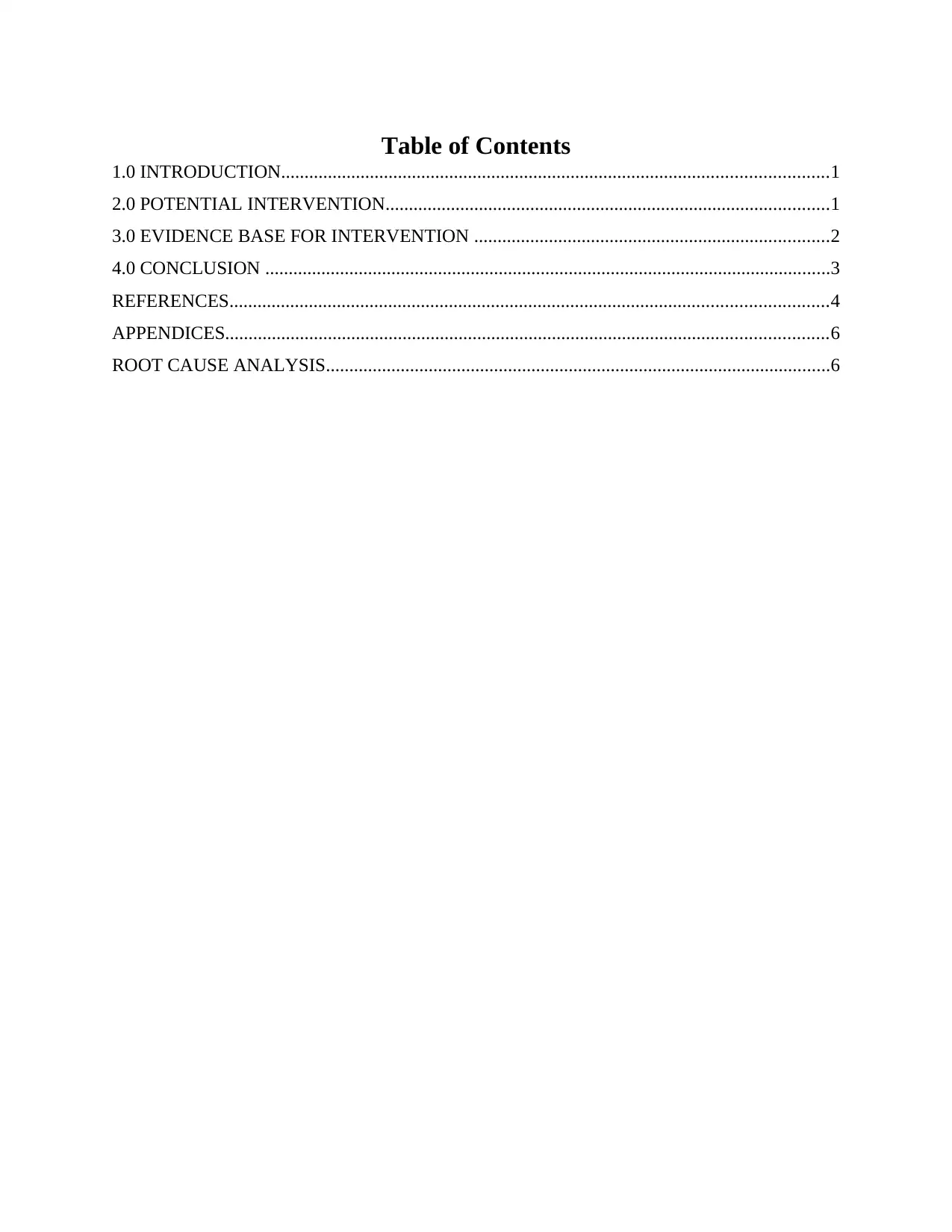
Table of Contents
1.0 INTRODUCTION.....................................................................................................................1
2.0 POTENTIAL INTERVENTION...............................................................................................1
3.0 EVIDENCE BASE FOR INTERVENTION ............................................................................2
4.0 CONCLUSION .........................................................................................................................3
REFERENCES................................................................................................................................4
APPENDICES.................................................................................................................................6
ROOT CAUSE ANALYSIS............................................................................................................6
1.0 INTRODUCTION.....................................................................................................................1
2.0 POTENTIAL INTERVENTION...............................................................................................1
3.0 EVIDENCE BASE FOR INTERVENTION ............................................................................2
4.0 CONCLUSION .........................................................................................................................3
REFERENCES................................................................................................................................4
APPENDICES.................................................................................................................................6
ROOT CAUSE ANALYSIS............................................................................................................6
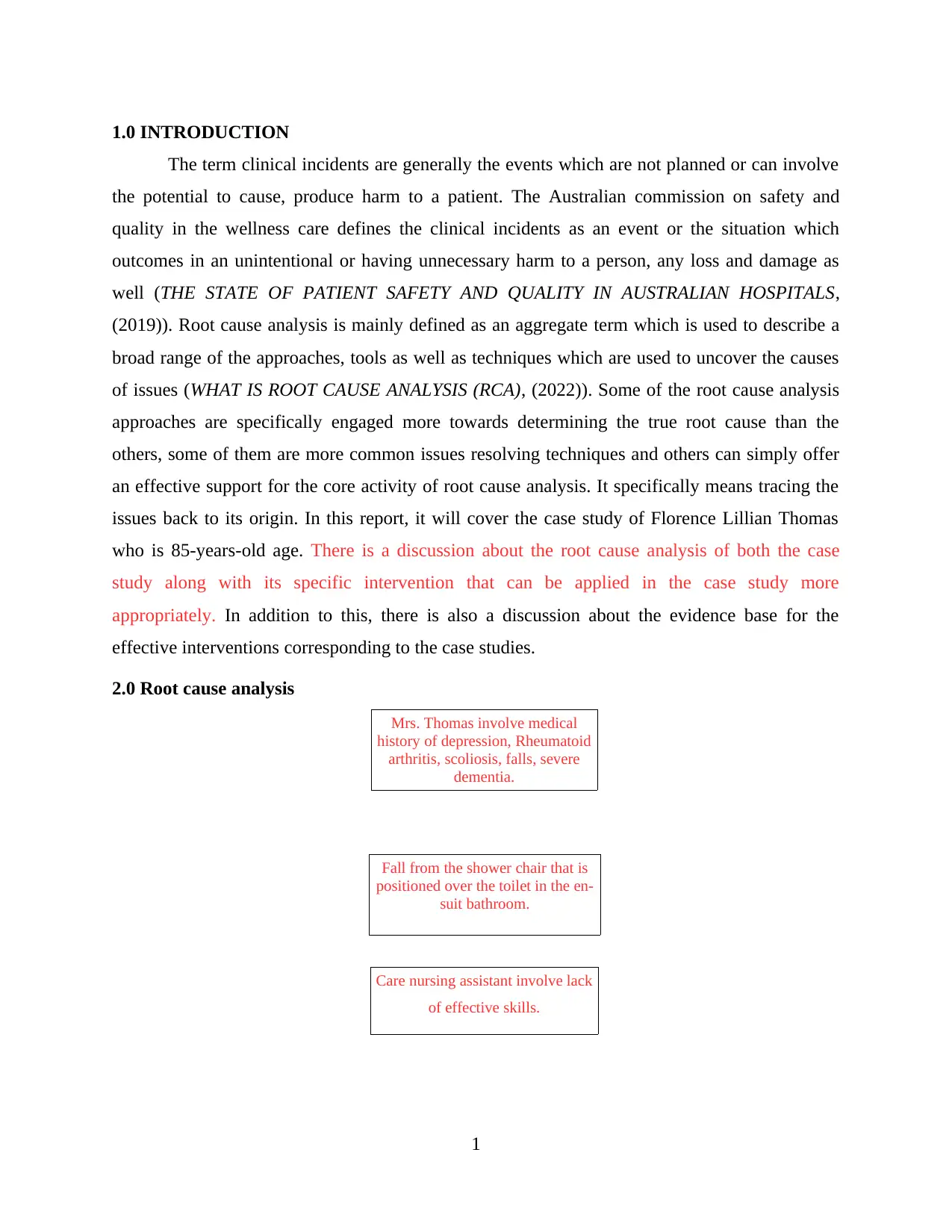
1.0 INTRODUCTION
The term clinical incidents are generally the events which are not planned or can involve
the potential to cause, produce harm to a patient. The Australian commission on safety and
quality in the wellness care defines the clinical incidents as an event or the situation which
outcomes in an unintentional or having unnecessary harm to a person, any loss and damage as
well (THE STATE OF PATIENT SAFETY AND QUALITY IN AUSTRALIAN HOSPITALS,
(2019)). Root cause analysis is mainly defined as an aggregate term which is used to describe a
broad range of the approaches, tools as well as techniques which are used to uncover the causes
of issues (WHAT IS ROOT CAUSE ANALYSIS (RCA), (2022)). Some of the root cause analysis
approaches are specifically engaged more towards determining the true root cause than the
others, some of them are more common issues resolving techniques and others can simply offer
an effective support for the core activity of root cause analysis. It specifically means tracing the
issues back to its origin. In this report, it will cover the case study of Florence Lillian Thomas
who is 85-years-old age. There is a discussion about the root cause analysis of both the case
study along with its specific intervention that can be applied in the case study more
appropriately. In addition to this, there is also a discussion about the evidence base for the
effective interventions corresponding to the case studies.
2.0 Root cause analysis
Mrs. Thomas involve medical
history of depression, Rheumatoid
arthritis, scoliosis, falls, severe
dementia.
Fall from the shower chair that is
positioned over the toilet in the en-
suit bathroom.
Care nursing assistant involve lack
of effective skills.
1
The term clinical incidents are generally the events which are not planned or can involve
the potential to cause, produce harm to a patient. The Australian commission on safety and
quality in the wellness care defines the clinical incidents as an event or the situation which
outcomes in an unintentional or having unnecessary harm to a person, any loss and damage as
well (THE STATE OF PATIENT SAFETY AND QUALITY IN AUSTRALIAN HOSPITALS,
(2019)). Root cause analysis is mainly defined as an aggregate term which is used to describe a
broad range of the approaches, tools as well as techniques which are used to uncover the causes
of issues (WHAT IS ROOT CAUSE ANALYSIS (RCA), (2022)). Some of the root cause analysis
approaches are specifically engaged more towards determining the true root cause than the
others, some of them are more common issues resolving techniques and others can simply offer
an effective support for the core activity of root cause analysis. It specifically means tracing the
issues back to its origin. In this report, it will cover the case study of Florence Lillian Thomas
who is 85-years-old age. There is a discussion about the root cause analysis of both the case
study along with its specific intervention that can be applied in the case study more
appropriately. In addition to this, there is also a discussion about the evidence base for the
effective interventions corresponding to the case studies.
2.0 Root cause analysis
Mrs. Thomas involve medical
history of depression, Rheumatoid
arthritis, scoliosis, falls, severe
dementia.
Fall from the shower chair that is
positioned over the toilet in the en-
suit bathroom.
Care nursing assistant involve lack
of effective skills.
1
⊘ This is a preview!⊘
Do you want full access?
Subscribe today to unlock all pages.

Trusted by 1+ million students worldwide
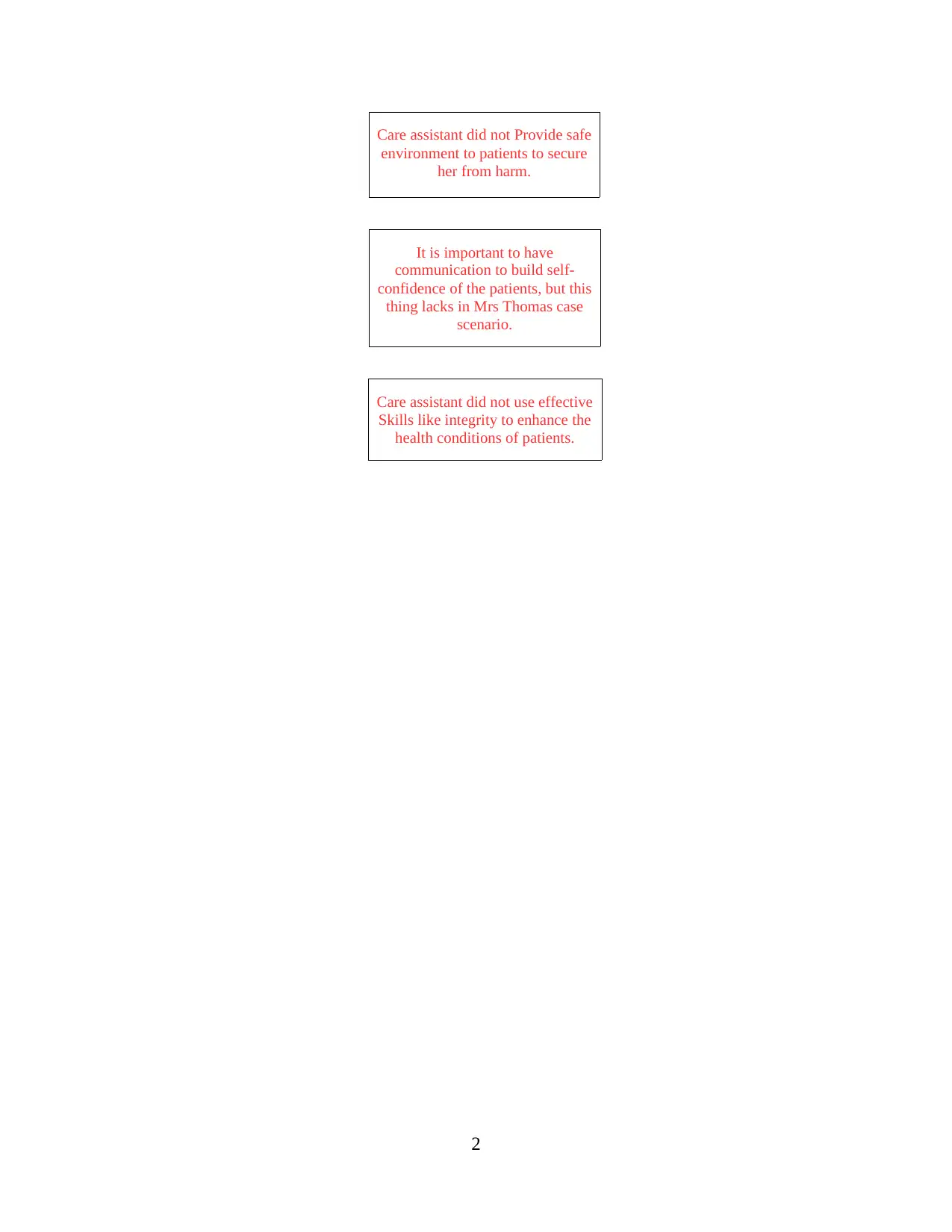
Care assistant did not Provide safe
environment to patients to secure
her from harm.
It is important to have
communication to build self-
confidence of the patients, but this
thing lacks in Mrs Thomas case
scenario.
Care assistant did not use effective
Skills like integrity to enhance the
health conditions of patients.
2
environment to patients to secure
her from harm.
It is important to have
communication to build self-
confidence of the patients, but this
thing lacks in Mrs Thomas case
scenario.
Care assistant did not use effective
Skills like integrity to enhance the
health conditions of patients.
2
Paraphrase This Document
Need a fresh take? Get an instant paraphrase of this document with our AI Paraphraser
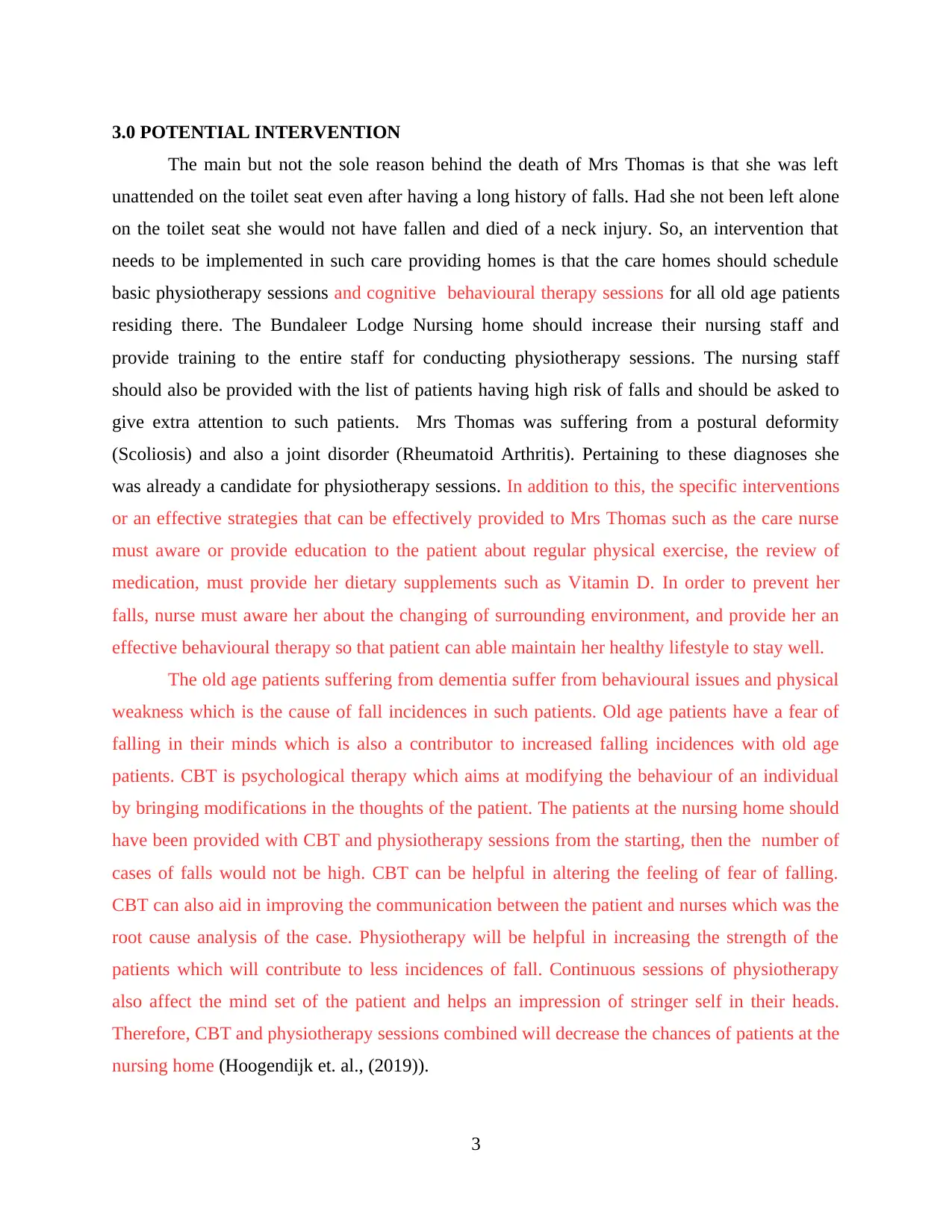
3.0 POTENTIAL INTERVENTION
The main but not the sole reason behind the death of Mrs Thomas is that she was left
unattended on the toilet seat even after having a long history of falls. Had she not been left alone
on the toilet seat she would not have fallen and died of a neck injury. So, an intervention that
needs to be implemented in such care providing homes is that the care homes should schedule
basic physiotherapy sessions and cognitive behavioural therapy sessions for all old age patients
residing there. The Bundaleer Lodge Nursing home should increase their nursing staff and
provide training to the entire staff for conducting physiotherapy sessions. The nursing staff
should also be provided with the list of patients having high risk of falls and should be asked to
give extra attention to such patients. Mrs Thomas was suffering from a postural deformity
(Scoliosis) and also a joint disorder (Rheumatoid Arthritis). Pertaining to these diagnoses she
was already a candidate for physiotherapy sessions. In addition to this, the specific interventions
or an effective strategies that can be effectively provided to Mrs Thomas such as the care nurse
must aware or provide education to the patient about regular physical exercise, the review of
medication, must provide her dietary supplements such as Vitamin D. In order to prevent her
falls, nurse must aware her about the changing of surrounding environment, and provide her an
effective behavioural therapy so that patient can able maintain her healthy lifestyle to stay well.
The old age patients suffering from dementia suffer from behavioural issues and physical
weakness which is the cause of fall incidences in such patients. Old age patients have a fear of
falling in their minds which is also a contributor to increased falling incidences with old age
patients. CBT is psychological therapy which aims at modifying the behaviour of an individual
by bringing modifications in the thoughts of the patient. The patients at the nursing home should
have been provided with CBT and physiotherapy sessions from the starting, then the number of
cases of falls would not be high. CBT can be helpful in altering the feeling of fear of falling.
CBT can also aid in improving the communication between the patient and nurses which was the
root cause analysis of the case. Physiotherapy will be helpful in increasing the strength of the
patients which will contribute to less incidences of fall. Continuous sessions of physiotherapy
also affect the mind set of the patient and helps an impression of stringer self in their heads.
Therefore, CBT and physiotherapy sessions combined will decrease the chances of patients at the
nursing home (Hoogendijk et. al., (2019)).
3
The main but not the sole reason behind the death of Mrs Thomas is that she was left
unattended on the toilet seat even after having a long history of falls. Had she not been left alone
on the toilet seat she would not have fallen and died of a neck injury. So, an intervention that
needs to be implemented in such care providing homes is that the care homes should schedule
basic physiotherapy sessions and cognitive behavioural therapy sessions for all old age patients
residing there. The Bundaleer Lodge Nursing home should increase their nursing staff and
provide training to the entire staff for conducting physiotherapy sessions. The nursing staff
should also be provided with the list of patients having high risk of falls and should be asked to
give extra attention to such patients. Mrs Thomas was suffering from a postural deformity
(Scoliosis) and also a joint disorder (Rheumatoid Arthritis). Pertaining to these diagnoses she
was already a candidate for physiotherapy sessions. In addition to this, the specific interventions
or an effective strategies that can be effectively provided to Mrs Thomas such as the care nurse
must aware or provide education to the patient about regular physical exercise, the review of
medication, must provide her dietary supplements such as Vitamin D. In order to prevent her
falls, nurse must aware her about the changing of surrounding environment, and provide her an
effective behavioural therapy so that patient can able maintain her healthy lifestyle to stay well.
The old age patients suffering from dementia suffer from behavioural issues and physical
weakness which is the cause of fall incidences in such patients. Old age patients have a fear of
falling in their minds which is also a contributor to increased falling incidences with old age
patients. CBT is psychological therapy which aims at modifying the behaviour of an individual
by bringing modifications in the thoughts of the patient. The patients at the nursing home should
have been provided with CBT and physiotherapy sessions from the starting, then the number of
cases of falls would not be high. CBT can be helpful in altering the feeling of fear of falling.
CBT can also aid in improving the communication between the patient and nurses which was the
root cause analysis of the case. Physiotherapy will be helpful in increasing the strength of the
patients which will contribute to less incidences of fall. Continuous sessions of physiotherapy
also affect the mind set of the patient and helps an impression of stringer self in their heads.
Therefore, CBT and physiotherapy sessions combined will decrease the chances of patients at the
nursing home (Hoogendijk et. al., (2019)).
3
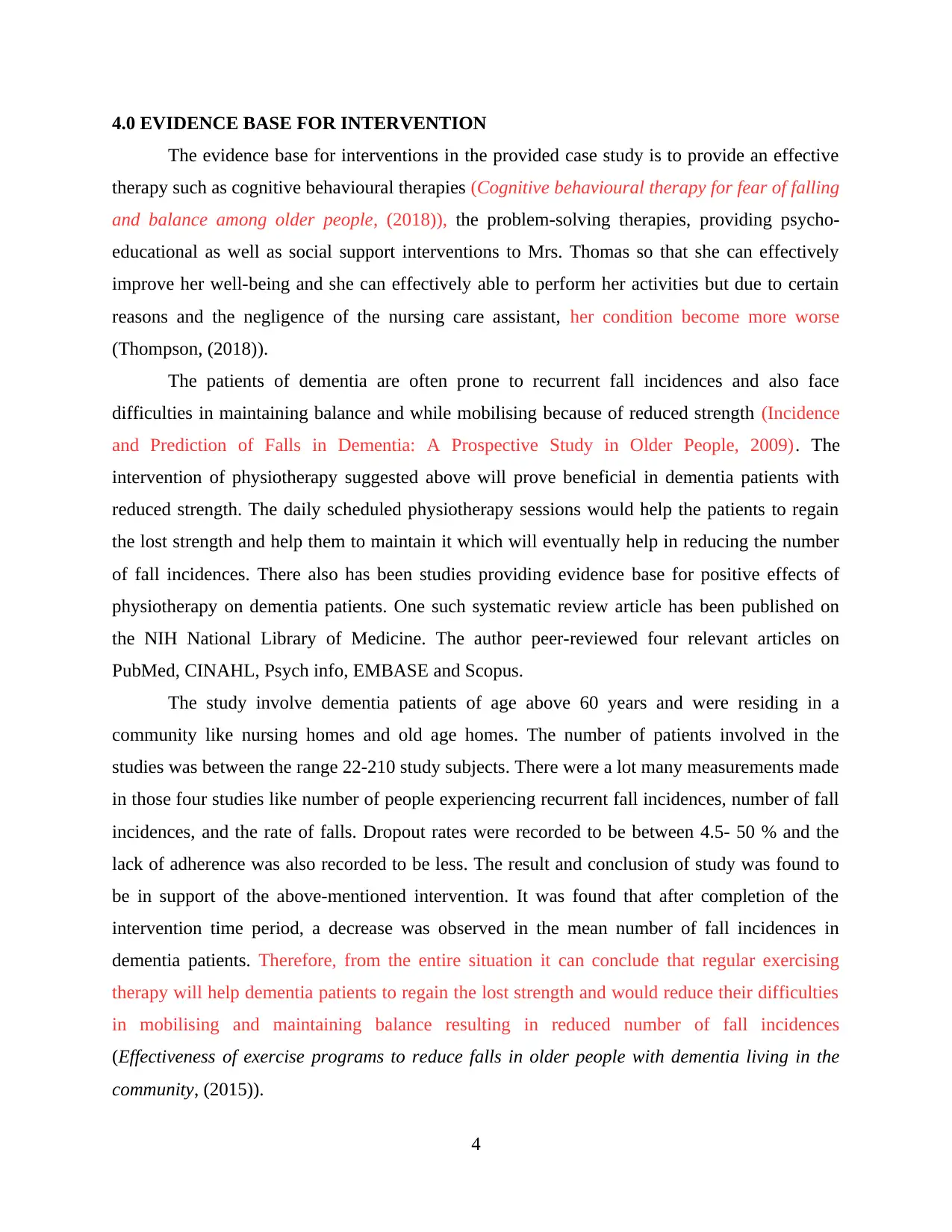
4.0 EVIDENCE BASE FOR INTERVENTION
The evidence base for interventions in the provided case study is to provide an effective
therapy such as cognitive behavioural therapies (Cognitive behavioural therapy for fear of falling
and balance among older people, (2018)), the problem-solving therapies, providing psycho-
educational as well as social support interventions to Mrs. Thomas so that she can effectively
improve her well-being and she can effectively able to perform her activities but due to certain
reasons and the negligence of the nursing care assistant, her condition become more worse
(Thompson, (2018)).
The patients of dementia are often prone to recurrent fall incidences and also face
difficulties in maintaining balance and while mobilising because of reduced strength (Incidence
and Prediction of Falls in Dementia: A Prospective Study in Older People, 2009). The
intervention of physiotherapy suggested above will prove beneficial in dementia patients with
reduced strength. The daily scheduled physiotherapy sessions would help the patients to regain
the lost strength and help them to maintain it which will eventually help in reducing the number
of fall incidences. There also has been studies providing evidence base for positive effects of
physiotherapy on dementia patients. One such systematic review article has been published on
the NIH National Library of Medicine. The author peer-reviewed four relevant articles on
PubMed, CINAHL, Psych info, EMBASE and Scopus.
The study involve dementia patients of age above 60 years and were residing in a
community like nursing homes and old age homes. The number of patients involved in the
studies was between the range 22-210 study subjects. There were a lot many measurements made
in those four studies like number of people experiencing recurrent fall incidences, number of fall
incidences, and the rate of falls. Dropout rates were recorded to be between 4.5- 50 % and the
lack of adherence was also recorded to be less. The result and conclusion of study was found to
be in support of the above-mentioned intervention. It was found that after completion of the
intervention time period, a decrease was observed in the mean number of fall incidences in
dementia patients. Therefore, from the entire situation it can conclude that regular exercising
therapy will help dementia patients to regain the lost strength and would reduce their difficulties
in mobilising and maintaining balance resulting in reduced number of fall incidences
(Effectiveness of exercise programs to reduce falls in older people with dementia living in the
community, (2015)).
4
The evidence base for interventions in the provided case study is to provide an effective
therapy such as cognitive behavioural therapies (Cognitive behavioural therapy for fear of falling
and balance among older people, (2018)), the problem-solving therapies, providing psycho-
educational as well as social support interventions to Mrs. Thomas so that she can effectively
improve her well-being and she can effectively able to perform her activities but due to certain
reasons and the negligence of the nursing care assistant, her condition become more worse
(Thompson, (2018)).
The patients of dementia are often prone to recurrent fall incidences and also face
difficulties in maintaining balance and while mobilising because of reduced strength (Incidence
and Prediction of Falls in Dementia: A Prospective Study in Older People, 2009). The
intervention of physiotherapy suggested above will prove beneficial in dementia patients with
reduced strength. The daily scheduled physiotherapy sessions would help the patients to regain
the lost strength and help them to maintain it which will eventually help in reducing the number
of fall incidences. There also has been studies providing evidence base for positive effects of
physiotherapy on dementia patients. One such systematic review article has been published on
the NIH National Library of Medicine. The author peer-reviewed four relevant articles on
PubMed, CINAHL, Psych info, EMBASE and Scopus.
The study involve dementia patients of age above 60 years and were residing in a
community like nursing homes and old age homes. The number of patients involved in the
studies was between the range 22-210 study subjects. There were a lot many measurements made
in those four studies like number of people experiencing recurrent fall incidences, number of fall
incidences, and the rate of falls. Dropout rates were recorded to be between 4.5- 50 % and the
lack of adherence was also recorded to be less. The result and conclusion of study was found to
be in support of the above-mentioned intervention. It was found that after completion of the
intervention time period, a decrease was observed in the mean number of fall incidences in
dementia patients. Therefore, from the entire situation it can conclude that regular exercising
therapy will help dementia patients to regain the lost strength and would reduce their difficulties
in mobilising and maintaining balance resulting in reduced number of fall incidences
(Effectiveness of exercise programs to reduce falls in older people with dementia living in the
community, (2015)).
4
⊘ This is a preview!⊘
Do you want full access?
Subscribe today to unlock all pages.

Trusted by 1+ million students worldwide
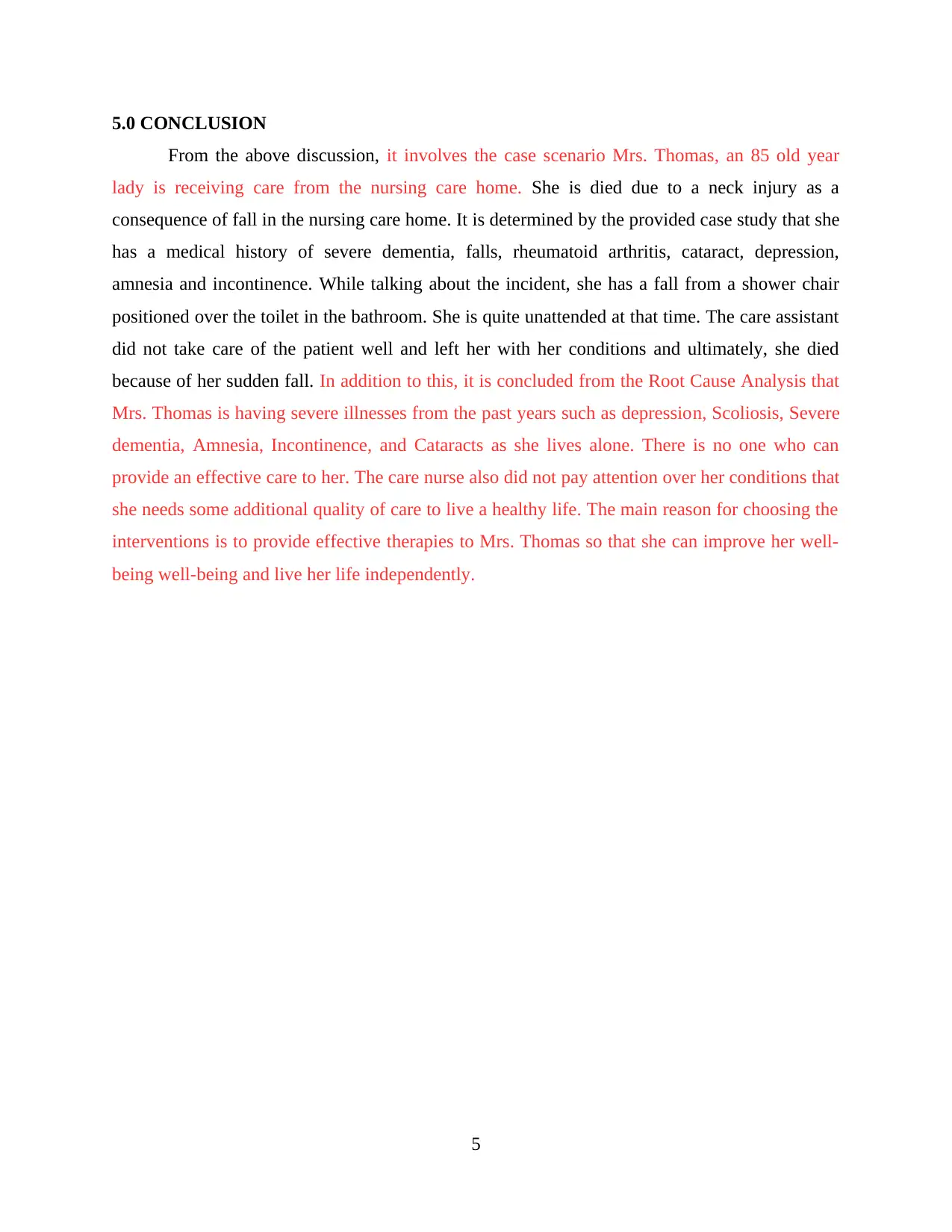
5.0 CONCLUSION
From the above discussion, it involves the case scenario Mrs. Thomas, an 85 old year
lady is receiving care from the nursing care home. She is died due to a neck injury as a
consequence of fall in the nursing care home. It is determined by the provided case study that she
has a medical history of severe dementia, falls, rheumatoid arthritis, cataract, depression,
amnesia and incontinence. While talking about the incident, she has a fall from a shower chair
positioned over the toilet in the bathroom. She is quite unattended at that time. The care assistant
did not take care of the patient well and left her with her conditions and ultimately, she died
because of her sudden fall. In addition to this, it is concluded from the Root Cause Analysis that
Mrs. Thomas is having severe illnesses from the past years such as depression, Scoliosis, Severe
dementia, Amnesia, Incontinence, and Cataracts as she lives alone. There is no one who can
provide an effective care to her. The care nurse also did not pay attention over her conditions that
she needs some additional quality of care to live a healthy life. The main reason for choosing the
interventions is to provide effective therapies to Mrs. Thomas so that she can improve her well-
being well-being and live her life independently.
5
From the above discussion, it involves the case scenario Mrs. Thomas, an 85 old year
lady is receiving care from the nursing care home. She is died due to a neck injury as a
consequence of fall in the nursing care home. It is determined by the provided case study that she
has a medical history of severe dementia, falls, rheumatoid arthritis, cataract, depression,
amnesia and incontinence. While talking about the incident, she has a fall from a shower chair
positioned over the toilet in the bathroom. She is quite unattended at that time. The care assistant
did not take care of the patient well and left her with her conditions and ultimately, she died
because of her sudden fall. In addition to this, it is concluded from the Root Cause Analysis that
Mrs. Thomas is having severe illnesses from the past years such as depression, Scoliosis, Severe
dementia, Amnesia, Incontinence, and Cataracts as she lives alone. There is no one who can
provide an effective care to her. The care nurse also did not pay attention over her conditions that
she needs some additional quality of care to live a healthy life. The main reason for choosing the
interventions is to provide effective therapies to Mrs. Thomas so that she can improve her well-
being well-being and live her life independently.
5
Paraphrase This Document
Need a fresh take? Get an instant paraphrase of this document with our AI Paraphraser
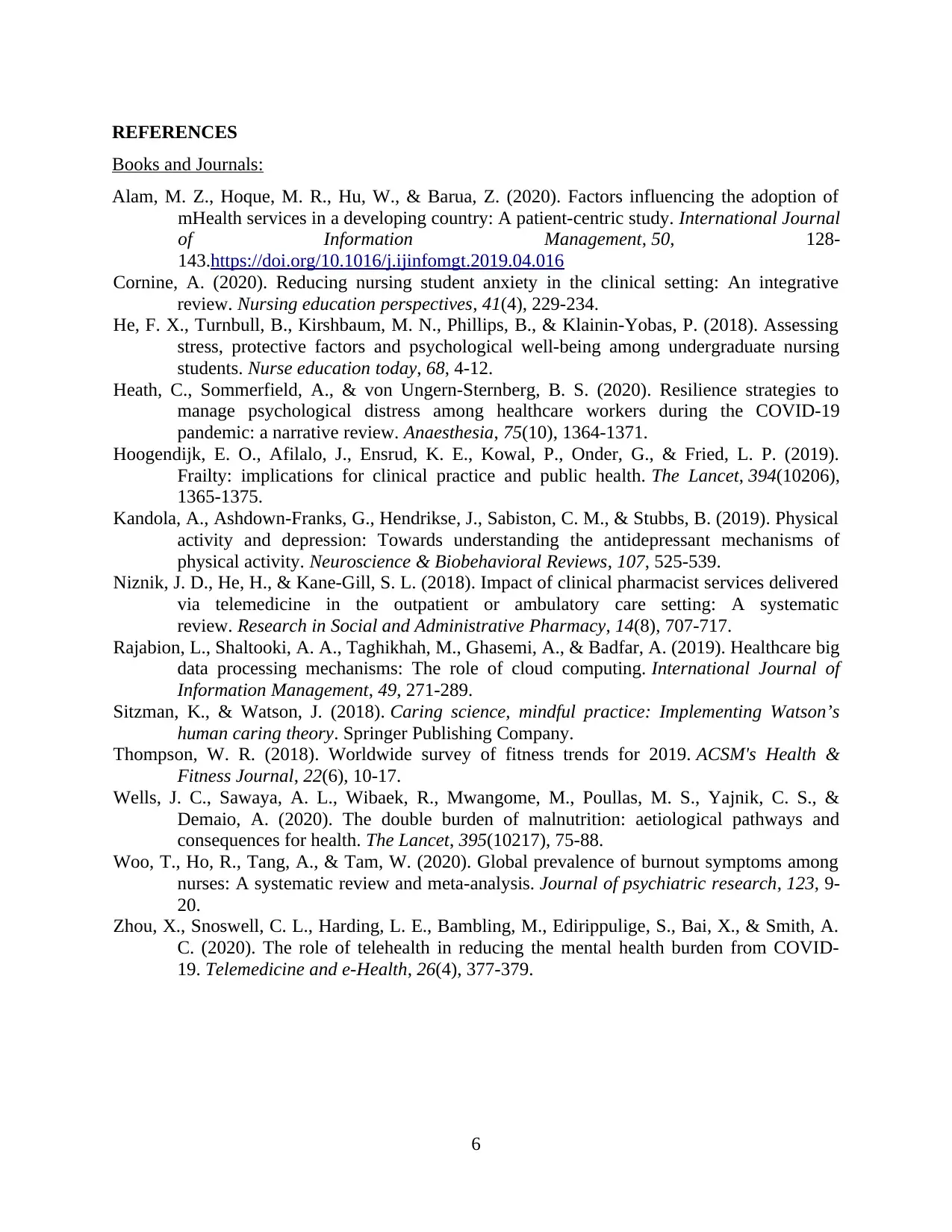
REFERENCES
Books and Journals:
Alam, M. Z., Hoque, M. R., Hu, W., & Barua, Z. (2020). Factors influencing the adoption of
mHealth services in a developing country: A patient-centric study. International Journal
of Information Management, 50, 128-
143.https://doi.org/10.1016/j.ijinfomgt.2019.04.016
Cornine, A. (2020). Reducing nursing student anxiety in the clinical setting: An integrative
review. Nursing education perspectives, 41(4), 229-234.
He, F. X., Turnbull, B., Kirshbaum, M. N., Phillips, B., & Klainin-Yobas, P. (2018). Assessing
stress, protective factors and psychological well-being among undergraduate nursing
students. Nurse education today, 68, 4-12.
Heath, C., Sommerfield, A., & von Ungern‐Sternberg, B. S. (2020). Resilience strategies to
manage psychological distress among healthcare workers during the COVID‐19
pandemic: a narrative review. Anaesthesia, 75(10), 1364-1371.
Hoogendijk, E. O., Afilalo, J., Ensrud, K. E., Kowal, P., Onder, G., & Fried, L. P. (2019).
Frailty: implications for clinical practice and public health. The Lancet, 394(10206),
1365-1375.
Kandola, A., Ashdown-Franks, G., Hendrikse, J., Sabiston, C. M., & Stubbs, B. (2019). Physical
activity and depression: Towards understanding the antidepressant mechanisms of
physical activity. Neuroscience & Biobehavioral Reviews, 107, 525-539.
Niznik, J. D., He, H., & Kane-Gill, S. L. (2018). Impact of clinical pharmacist services delivered
via telemedicine in the outpatient or ambulatory care setting: A systematic
review. Research in Social and Administrative Pharmacy, 14(8), 707-717.
Rajabion, L., Shaltooki, A. A., Taghikhah, M., Ghasemi, A., & Badfar, A. (2019). Healthcare big
data processing mechanisms: The role of cloud computing. International Journal of
Information Management, 49, 271-289.
Sitzman, K., & Watson, J. (2018). Caring science, mindful practice: Implementing Watson’s
human caring theory. Springer Publishing Company.
Thompson, W. R. (2018). Worldwide survey of fitness trends for 2019. ACSM's Health &
Fitness Journal, 22(6), 10-17.
Wells, J. C., Sawaya, A. L., Wibaek, R., Mwangome, M., Poullas, M. S., Yajnik, C. S., &
Demaio, A. (2020). The double burden of malnutrition: aetiological pathways and
consequences for health. The Lancet, 395(10217), 75-88.
Woo, T., Ho, R., Tang, A., & Tam, W. (2020). Global prevalence of burnout symptoms among
nurses: A systematic review and meta-analysis. Journal of psychiatric research, 123, 9-
20.
Zhou, X., Snoswell, C. L., Harding, L. E., Bambling, M., Edirippulige, S., Bai, X., & Smith, A.
C. (2020). The role of telehealth in reducing the mental health burden from COVID-
19. Telemedicine and e-Health, 26(4), 377-379.
6
Books and Journals:
Alam, M. Z., Hoque, M. R., Hu, W., & Barua, Z. (2020). Factors influencing the adoption of
mHealth services in a developing country: A patient-centric study. International Journal
of Information Management, 50, 128-
143.https://doi.org/10.1016/j.ijinfomgt.2019.04.016
Cornine, A. (2020). Reducing nursing student anxiety in the clinical setting: An integrative
review. Nursing education perspectives, 41(4), 229-234.
He, F. X., Turnbull, B., Kirshbaum, M. N., Phillips, B., & Klainin-Yobas, P. (2018). Assessing
stress, protective factors and psychological well-being among undergraduate nursing
students. Nurse education today, 68, 4-12.
Heath, C., Sommerfield, A., & von Ungern‐Sternberg, B. S. (2020). Resilience strategies to
manage psychological distress among healthcare workers during the COVID‐19
pandemic: a narrative review. Anaesthesia, 75(10), 1364-1371.
Hoogendijk, E. O., Afilalo, J., Ensrud, K. E., Kowal, P., Onder, G., & Fried, L. P. (2019).
Frailty: implications for clinical practice and public health. The Lancet, 394(10206),
1365-1375.
Kandola, A., Ashdown-Franks, G., Hendrikse, J., Sabiston, C. M., & Stubbs, B. (2019). Physical
activity and depression: Towards understanding the antidepressant mechanisms of
physical activity. Neuroscience & Biobehavioral Reviews, 107, 525-539.
Niznik, J. D., He, H., & Kane-Gill, S. L. (2018). Impact of clinical pharmacist services delivered
via telemedicine in the outpatient or ambulatory care setting: A systematic
review. Research in Social and Administrative Pharmacy, 14(8), 707-717.
Rajabion, L., Shaltooki, A. A., Taghikhah, M., Ghasemi, A., & Badfar, A. (2019). Healthcare big
data processing mechanisms: The role of cloud computing. International Journal of
Information Management, 49, 271-289.
Sitzman, K., & Watson, J. (2018). Caring science, mindful practice: Implementing Watson’s
human caring theory. Springer Publishing Company.
Thompson, W. R. (2018). Worldwide survey of fitness trends for 2019. ACSM's Health &
Fitness Journal, 22(6), 10-17.
Wells, J. C., Sawaya, A. L., Wibaek, R., Mwangome, M., Poullas, M. S., Yajnik, C. S., &
Demaio, A. (2020). The double burden of malnutrition: aetiological pathways and
consequences for health. The Lancet, 395(10217), 75-88.
Woo, T., Ho, R., Tang, A., & Tam, W. (2020). Global prevalence of burnout symptoms among
nurses: A systematic review and meta-analysis. Journal of psychiatric research, 123, 9-
20.
Zhou, X., Snoswell, C. L., Harding, L. E., Bambling, M., Edirippulige, S., Bai, X., & Smith, A.
C. (2020). The role of telehealth in reducing the mental health burden from COVID-
19. Telemedicine and e-Health, 26(4), 377-379.
6
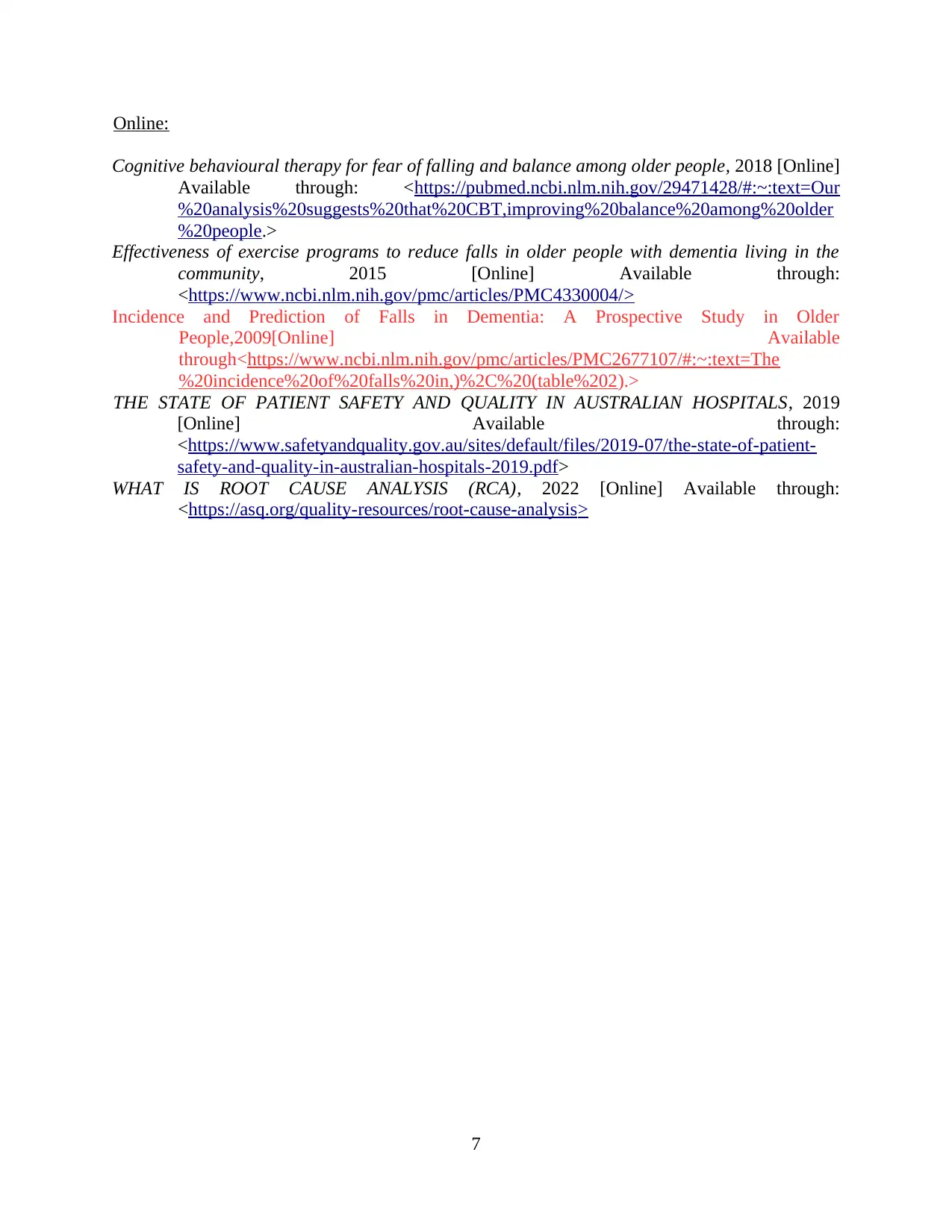
Online:
Cognitive behavioural therapy for fear of falling and balance among older people, 2018 [Online]
Available through: <https://pubmed.ncbi.nlm.nih.gov/29471428/#:~:text=Our
%20analysis%20suggests%20that%20CBT,improving%20balance%20among%20older
%20people.>
Effectiveness of exercise programs to reduce falls in older people with dementia living in the
community, 2015 [Online] Available through:
<https://www.ncbi.nlm.nih.gov/pmc/articles/PMC4330004/>
Incidence and Prediction of Falls in Dementia: A Prospective Study in Older
People,2009[Online] Available
through<https://www.ncbi.nlm.nih.gov/pmc/articles/PMC2677107/#:~:text=The
%20incidence%20of%20falls%20in,)%2C%20(table%202).>
THE STATE OF PATIENT SAFETY AND QUALITY IN AUSTRALIAN HOSPITALS, 2019
[Online] Available through:
<https://www.safetyandquality.gov.au/sites/default/files/2019-07/the-state-of-patient-
safety-and-quality-in-australian-hospitals-2019.pdf>
WHAT IS ROOT CAUSE ANALYSIS (RCA), 2022 [Online] Available through:
<https://asq.org/quality-resources/root-cause-analysis>
7
Cognitive behavioural therapy for fear of falling and balance among older people, 2018 [Online]
Available through: <https://pubmed.ncbi.nlm.nih.gov/29471428/#:~:text=Our
%20analysis%20suggests%20that%20CBT,improving%20balance%20among%20older
%20people.>
Effectiveness of exercise programs to reduce falls in older people with dementia living in the
community, 2015 [Online] Available through:
<https://www.ncbi.nlm.nih.gov/pmc/articles/PMC4330004/>
Incidence and Prediction of Falls in Dementia: A Prospective Study in Older
People,2009[Online] Available
through<https://www.ncbi.nlm.nih.gov/pmc/articles/PMC2677107/#:~:text=The
%20incidence%20of%20falls%20in,)%2C%20(table%202).>
THE STATE OF PATIENT SAFETY AND QUALITY IN AUSTRALIAN HOSPITALS, 2019
[Online] Available through:
<https://www.safetyandquality.gov.au/sites/default/files/2019-07/the-state-of-patient-
safety-and-quality-in-australian-hospitals-2019.pdf>
WHAT IS ROOT CAUSE ANALYSIS (RCA), 2022 [Online] Available through:
<https://asq.org/quality-resources/root-cause-analysis>
7
⊘ This is a preview!⊘
Do you want full access?
Subscribe today to unlock all pages.

Trusted by 1+ million students worldwide
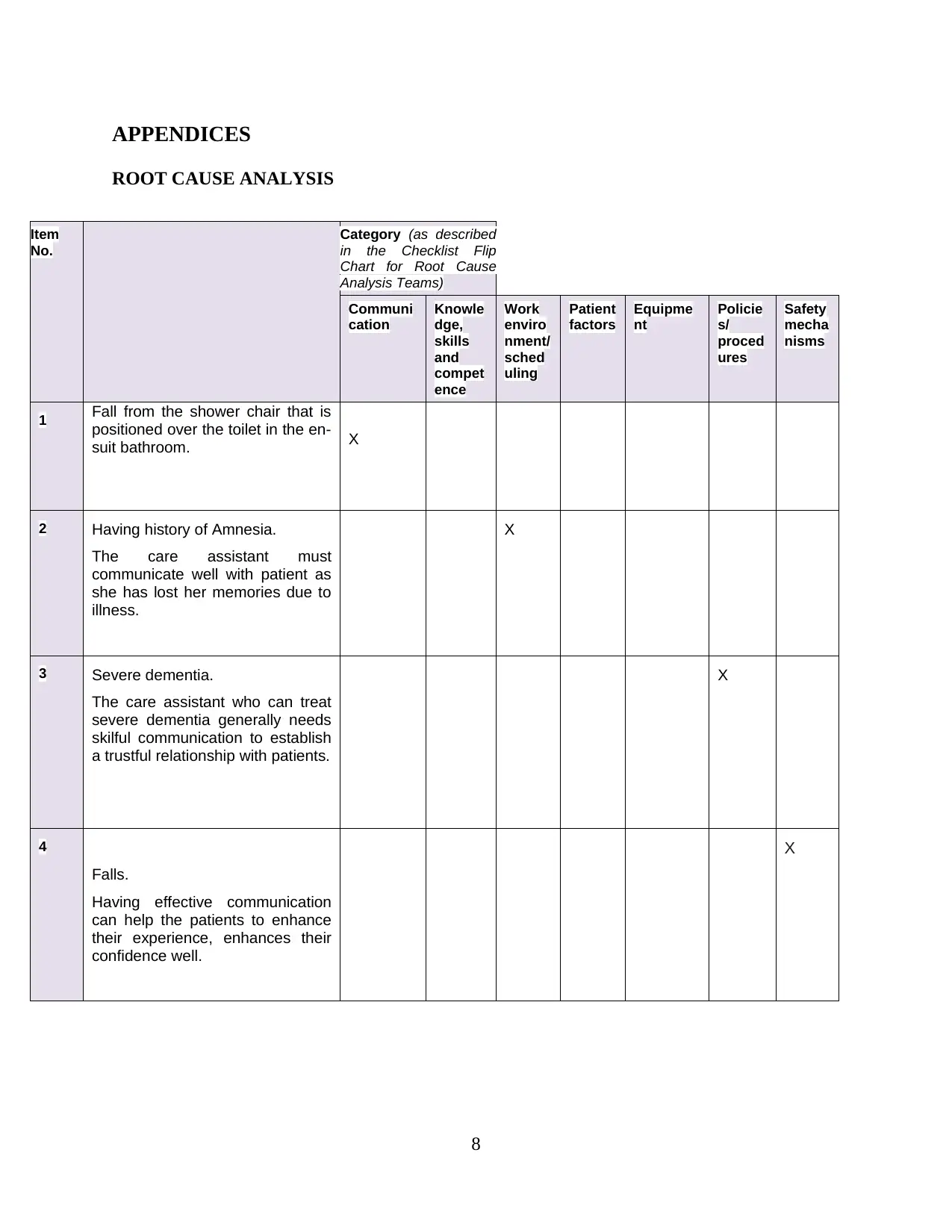
APPENDICES
ROOT CAUSE ANALYSIS
Item
No.
Category (as described
in the Checklist Flip
Chart for Root Cause
Analysis Teams)
Communi
cation
Knowle
dge,
skills
and
compet
ence
Work
enviro
nment/
sched
uling
Patient
factors
Equipme
nt
Policie
s/
proced
ures
Safety
mecha
nisms
1 Fall from the shower chair that is
positioned over the toilet in the en-
suit bathroom. X
2 Having history of Amnesia.
The care assistant must
communicate well with patient as
she has lost her memories due to
illness.
X
3 Severe dementia.
The care assistant who can treat
severe dementia generally needs
skilful communication to establish
a trustful relationship with patients.
X
4
Falls.
Having effective communication
can help the patients to enhance
their experience, enhances their
confidence well.
X
8
ROOT CAUSE ANALYSIS
Item
No.
Category (as described
in the Checklist Flip
Chart for Root Cause
Analysis Teams)
Communi
cation
Knowle
dge,
skills
and
compet
ence
Work
enviro
nment/
sched
uling
Patient
factors
Equipme
nt
Policie
s/
proced
ures
Safety
mecha
nisms
1 Fall from the shower chair that is
positioned over the toilet in the en-
suit bathroom. X
2 Having history of Amnesia.
The care assistant must
communicate well with patient as
she has lost her memories due to
illness.
X
3 Severe dementia.
The care assistant who can treat
severe dementia generally needs
skilful communication to establish
a trustful relationship with patients.
X
4
Falls.
Having effective communication
can help the patients to enhance
their experience, enhances their
confidence well.
X
8
Paraphrase This Document
Need a fresh take? Get an instant paraphrase of this document with our AI Paraphraser
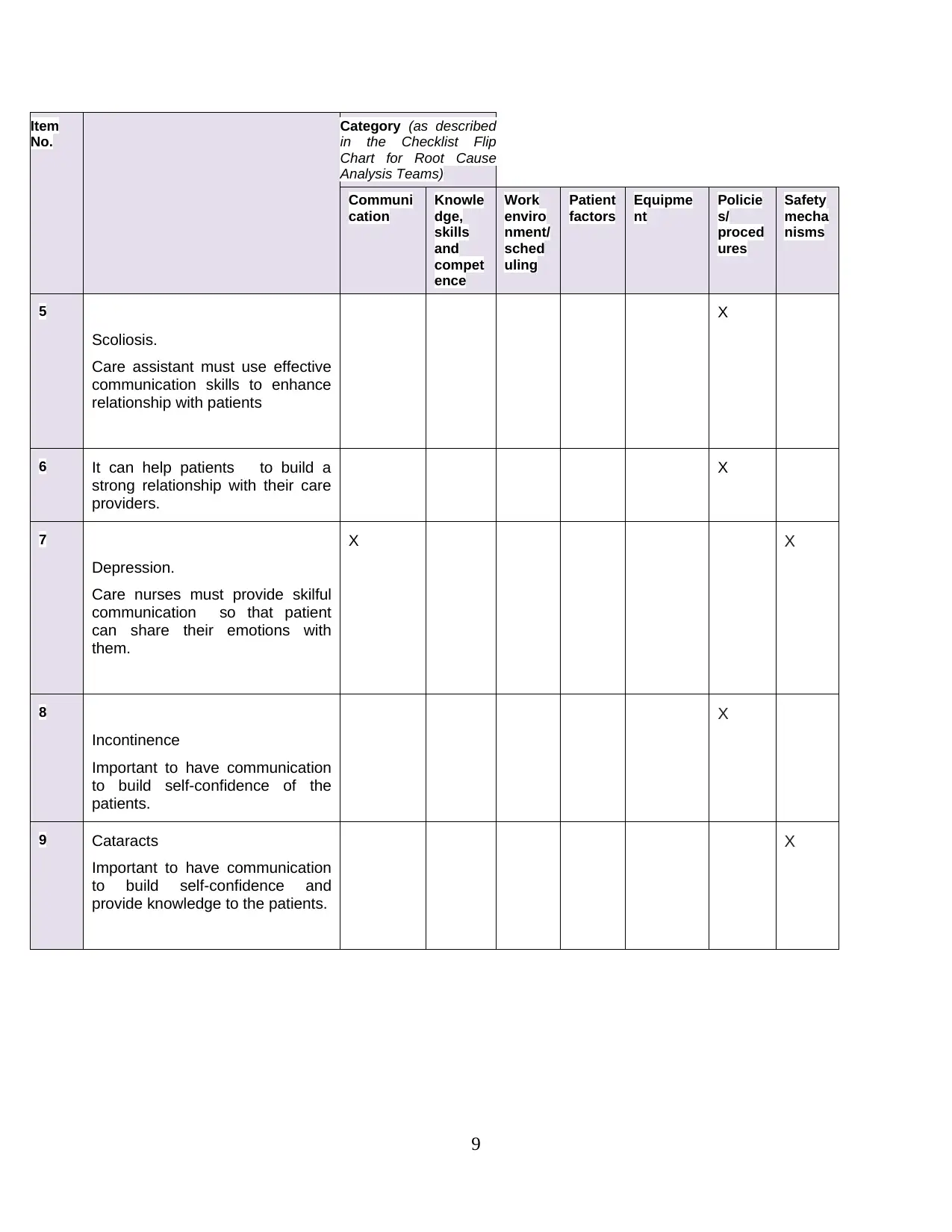
Item
No.
Category (as described
in the Checklist Flip
Chart for Root Cause
Analysis Teams)
Communi
cation
Knowle
dge,
skills
and
compet
ence
Work
enviro
nment/
sched
uling
Patient
factors
Equipme
nt
Policie
s/
proced
ures
Safety
mecha
nisms
5
Scoliosis.
Care assistant must use effective
communication skills to enhance
relationship with patients
X
6 It can help patients to build a
strong relationship with their care
providers.
X
7
Depression.
Care nurses must provide skilful
communication so that patient
can share their emotions with
them.
X X
8
Incontinence
Important to have communication
to build self-confidence of the
patients.
X
9 Cataracts
Important to have communication
to build self-confidence and
provide knowledge to the patients.
X
9
No.
Category (as described
in the Checklist Flip
Chart for Root Cause
Analysis Teams)
Communi
cation
Knowle
dge,
skills
and
compet
ence
Work
enviro
nment/
sched
uling
Patient
factors
Equipme
nt
Policie
s/
proced
ures
Safety
mecha
nisms
5
Scoliosis.
Care assistant must use effective
communication skills to enhance
relationship with patients
X
6 It can help patients to build a
strong relationship with their care
providers.
X
7
Depression.
Care nurses must provide skilful
communication so that patient
can share their emotions with
them.
X X
8
Incontinence
Important to have communication
to build self-confidence of the
patients.
X
9 Cataracts
Important to have communication
to build self-confidence and
provide knowledge to the patients.
X
9
1 out of 11
Related Documents
Your All-in-One AI-Powered Toolkit for Academic Success.
+13062052269
info@desklib.com
Available 24*7 on WhatsApp / Email
![[object Object]](/_next/static/media/star-bottom.7253800d.svg)
Unlock your academic potential
Copyright © 2020–2025 A2Z Services. All Rights Reserved. Developed and managed by ZUCOL.





